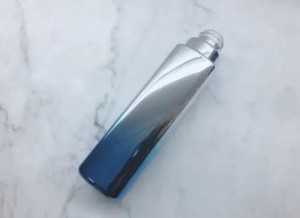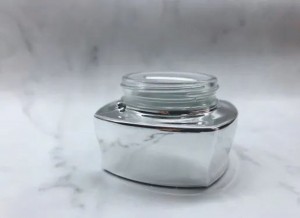Common materials and applications of vacuum coating
Definition and Characteristics
Physical Vapor Deposition (PVD), also known as Vacuum Deposition or Vacuum Metalization (VM), is a process in which a metal material is changed from a solid to a gaseous substance under vacuum conditions using the PVD method, and then coalesced and deposited on the surface of a substrate to form a metallized film.
(Glass vacuum coating products)
This process can make the plastic surface to form a bright metal layer, and the back channel is suitable for paint spraying, easy color matching, good decorative effect, by the plastic decoration industry in general, is an important means of plastic metallization.
Vacuum coating on the surface of plastic products can be divided into functional coating and decorative coating.
Functional coating can improve the physical and chemical properties of the plastic surface, such as electrical conductivity, barrier, etc.; decorative coating can make the surface of plastic products with metallized luster, and can present different colors and effects according to the actual needs.
(PP vacuum coating products)
Vacuum coating technology has great advantages compared with the traditional plating method, and has huge advantages in terms of cost and environmental protection. Therefore, it is widely used and also occupies a very important position in the decoration of cosmetic packages.
Development history of vacuum coating technology
The application of vacuum coating technology is very early. early 20th century Edison put forward the record wax film using cathodic sputtering for surface metallization process method, and declared a patent in 1903; during World War II, Germany used this technology to prepare a variety of military optical lenses and reflectors; 1930 oil diffusion pump made of evaporative coating machine with a wide range of practical value was introduced; 1940s, coating technology has been applied to metal and paper as an important means of metallization; 1950s, vacuum coating technology began to be applied to electrical equipment; with the development of plastic decorative coating and plastic to replace metal products continue to promote the development of vacuum coating technology is increasingly applied to plastic metallization, the 1970s began to gradually apply in automotive exterior parts, cosmetic packaging materials, toys, daily commodities and rapid growth.
The general metallization methods on plastic are vacuum evaporation plating and vacuum sputtering plating.
(Comparison of the characteristics of vacuum evaporation plating and magnetron sputtering plating)
In the field of cosmetic packaging materials, vacuum evaporation plating was developed earlier and is the most widely used. Vacuum sputtering plating is not as widely used, but because sputtering plating does not require replenishment of the coating material, it can easily achieve long continuous operation.
Introduction of common coating materials
Vacuum coating materials are materials that are deposited on the substrate by vacuum coating to form a coating layer.
The performance and color of the deposited layer vary depending on the coating material. At present, the metal materials used in the vacuum evaporation coating process are generally low melting point metals: indium (156.61 ℃), tin (232 ℃), magnesium (651 ℃), zinc (419.53 ℃), aluminum (660 ℃), copper (1083.4 ℃), silver (961.78 ℃), gold (1063 ℃), while the need to consider the chemical stability of the coating, for example: tin at low temperature For example: tin will self-destruct at low temperatures, magnesium, zinc chemically active, easy to chemical reaction with non-metals and deterioration, are not suitable as coating materials.
(Reflectivity and transmittance of different thicknesses of aluminum coating layers)
Therefore, in the field of cosmetic packaging materials, aluminum is the main coating material because of its low melting point, chemical stability, suitable cost, strong adhesion to plastic coating, and good metallic luster.
Substrate suitability
There are many types of plastic substrates that can be suitable for direct vacuum coating, for example, PET film can be vacuum coated directly on the film, and ABS material can also be used as a direct coating material because of its good adhesion and heat resistance.
(ABS vacuum coating products)
As a plastic substrate for vacuum coating, the following indicators must be considered.
01
Adhesion
The material to be coated should have good adhesion bonding strength with the vacuum coating material, which is related to the polarity of the plastic itself.
It is generally believed that polyester materials have the strongest adhesion to aluminum plating, while PP, PE and other weak polar materials have poor adhesion. When coating directly on the substrate, the cleanliness of the plastic surface must be carefully considered. The presence of oil, release agents, etc. may produce pinholes in light cases, or lead to uneven plating or even peeling in heavy cases. At the same time, because the plastic is easy to carry static electricity and its own strong water absorption, especially after the inclusion of some inorganic powder, the presence of water will also reduce the plastic surface activity, affecting the combination of plating and plastic surface.
02
Plastic surface flatness
In order to achieve a bright metal film layer and produce a good decorative effect, there are very strict requirements for the surface flatness of the substrate.
Generally speaking, the thickness of the aluminum layer of vacuum coating is below 100-200nm, which means that if the surface roughness of the substrate is greater than 200nm, the coating layer cannot cover the defects and the difference will be magnified due to the high gloss and high brightness of the metal layer. As for general injection molded products, it is difficult to achieve the flatness needed for aluminum coating because the flatness of the inner cavity of the mold is mostly above 500nm.
In the trend of increasingly pursuing delicate appearance, direct coating of injection molded parts is very difficult. The biaxially oriented PET film can achieve the required flatness and can be directly coated.
In the general process of injection molded products, the surface flatness of the product is adjusted to the requirement of coating by spraying primer, and the direct coating process is very rarely used.
Main applications of vacuum vapor deposition
The main functions of vacuum vapor deposition include giving the surface of coated parts a high metallic luster and mirror effect, or special color effects and optical properties, and providing excellent moisture and oxygen barrier properties in thin film materials.

(PET/PETG vacuum coating products)
Vacuum coating can have various applications depending on the coating material and thickness.
01
Optical film
Optical coatings are made by combining thin film layers, which produce interference effects to improve transmission or reflection properties within an optical system.
The performance of optical coatings depends on the number of layers, the thickness of individual layers, and the refractive index of the different layer interfaces. The most common types of coatings used for precision optics are: transmission-enhancing (AR) films, highly reflective (mirror) films, beamsplitter films, and periflitter films.
Transmittance-enhancing films are included in high-refractive-index optics and are used to maximize luminous flux and reduce ghosting. Highly reflective films maximize reflection at a single wavelength or a wide range of entire wavelengths. Beamsplitter films are used to divide incident light into known transmitted and reflected light outputs. Filters are used in a large number of industrial applications to transmit, reflect, absorb or attenuate light at specific wavelengths.
Optical coatings are made from deposited dielectrics and metallic materials such as Ta₂O₅ and/or Al₂O₃ in thin layers, and the wavelengths of light used in the application are typically quarter-wavelength optical thickness (QWOT) or half-wave optical thickness ( HWOT). These films consist of alternating high and low refractive index layers, thus inducing the desired interference effects.
02
Functional Films
Using the coating process, a layer of film with various functions is formed on the product surface, allowing cost savings as well as adaptation to various shapes of products.
General functions: antibacterial, antistatic, virus resistant; surface protection performance: scratch resistance, fingerprint resistance, water resistance, moisture resistance, oxygen permeation isolation; electrical and optical properties: electric wave transmission, infrared transmission, reflection, EMI (electromagnetic wave shielding).
(1) infrared reflective film: mainly used in architectural LOW-E glass, automotive thermal film, etc. The principle is to use the vapor deposition layer in the infrared region has a high reflectivity, and in the visible region has a high transmittance, so that the film or glass made that is effective in projecting light, but also effective in blocking heat. Semiconductor true coating film, metal true coating film, metal-media true coating film and full media true coating film are some types of thermal insulation films.
The advantage of metal film is that it can be deposited at very low temperature, but in order to ensure the visible light transmission rate, the thickness must be controlled, generally not more than 20nm.
(Common metal film reflectivity)
(2) non-conductive wave penetration vapor deposition (non-conductive metal film): mainly used for cell phone backplane or cell phone bezel, the principle of physical vapor deposition of a layer of metal or metal compound film on the surface of the product, so that the surface of the product has a metallic luster and color, and requires the film layer has a large resistance, generally silver-white non-conductive film is the main.
Example: In conventional coating materials, metal silver in the thickness of 5nm or less is not conductive, while the thickness of aluminum as long as 0.9nm to have conductivity, because the continuity of silver is not very good, in the case of thick film conductivity is poor. In fact, metal non-conductive film is the use of the principle of poor molecular continuity of certain metals, the thickness of the control in a certain range, so that it has a silver appearance and resistance is very large.
03
Decorative films
Vacuum coating can deposit a very thin layer on the surface of the substrate, especially a metallic layer, which can change the appearance of the substrate, thus giving the product a metal-like appearance (deposited metal or metal oxide film), which is increasingly used in plastic and paper packaging because it retains most of the properties of the original substrate and its cost is very low.
Changing the coating material can be a different metal to bring different color appearance, can be a different medium to bring the optical effect, or can be a different shape of the substrate to produce a special pattern and effect.
(Chromium plating effect [matte coating])
In the field of cosmetic packaging materials, the new effect of decorative coating is increasingly popular among consumers.
Post time: Dec-01-2022
